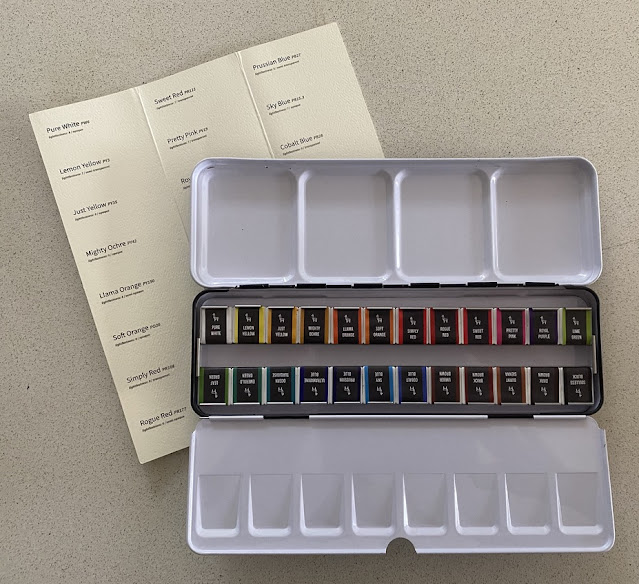I was sent a few sample dots of Wichitrong Watercolours - an artist quality range from Thailand.
This is a modest range of 24 colours, many single pigments. The only listed ingredients I could find are pigment and gum Arabic, though they feel as though there may also be a honey-like ingredient as well.
Wichitrong watercolours, taken from the Sikpakorn product catalogue

The pigment information is difficult fo find, so I will list it here. The bold colours are those I have tried, shown below.
801 Titanium White: PW6 (Titanium Dioxide) Series1
803 Lemon Yellow: PY3 (Monoazo) Series 1
805 Azo Yellow: PY154 (Benzimidazolone) Series 1
808 Cadmium Yellow Medium: PY37 (Cadmium) Series 3
809 Gamboge: PY154 (Benzimidazolone) + PY42 (Iron Oxide) + PY83 (Diarylide) Series 2
811 Cadmium Orange: PO20 (Cadmium) Series 3
813 Permanent Red: PR254 (Diketo-Pyrrolo-Pyrrolo) Series 2
816 Crimson Lake: PR177 (Anthraquinone) Series 3
817 Rose Madder: PV19 (Quinacridone) Series 3
819 Deep Magenta: PR122 (Quinacridone) Series 3
820 Dioxazine Purple: PV23 (Dioxazine) + PV23 (Carbazole Dioxazine) Series 2
821 Mauve: PV24 (Dioxazine) = PR81 (Rhodiamine Red) Series 2
822 Ultramarine Blue: PB29: (Ultramarine Blue) + PB28 (CoAI2O4) Series 1
825 Phthalo Blue: PB15.3 (Cu Phthalo.Blue) Series 1
826 Cobalt Blue: PB28 (CoAI2O4) Series 3
827 Cerulean Blue: PG50 (Co2TiO4) + PB28 (Cobalt Aluminium Spinel) Series 3
829 Phthalo Green: PG7 (Cu Phthalo Green) Series 1
831 Sap Green: PY83 (Diarylide) + PY168 (Monoazo Yellow) + PG7 ( Cu Phthalo.Green) Series 2
832 Leaf Green: PY154 (Benzimidazolone) + PG7 (Cu Phthalo.Green) Series 2
834 Raw Sienna: PY42 (Synthetic Hydrated Iron Oxide) + PBr7 (Calcined Natural Iron Oxide) + PY1 (Monoazo) + PR101 (Iron Oxide) Series 1
837 Burnt Sienna: PBr7 (Calcined Natural Iron Oxide) Series 1
848 Burnt Umber: PR101 (Irone Oxide) + PY42 (Synthetic Hydrated Iron Oxide) + PB15.3 (Cu Phthalo.Blue) Series 1
840 Payne's Grey: PB15.3 (Cu Phthalo.Blue) + PBk7 (CArbone Black) + PV19 (Quinacridone) Series 1
Here are the samples I tried. They are finely ground pigments that painted out nice and richly. The Burnt Sienna has a very yellow undertone so will mix greens rather than greys with Ultramarine.
Wichitrong Watercolours - Burnt Sienna, Azo Yellow, Permanent Red and Rose Madder.
Ultramarine has cobalt blue as an additional pigment which is unusual. Cerulean is made from Cobalt blue and cobalt green pigments so should still be liftable, even though it is not made from genuine cerulean blue PB36 or PB35. It is a lovely bright cerulean hue.
Wichitrong Watercolours - Ultramarine Blue, Phthalo Blue, PHthalo Green and Cerulean.
Happy painting.


























